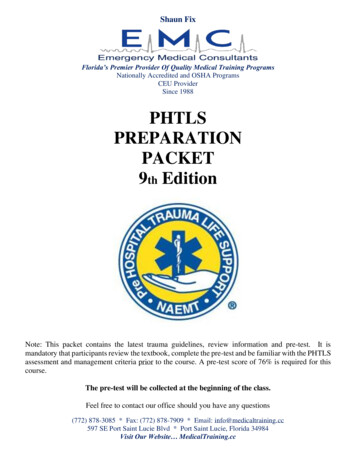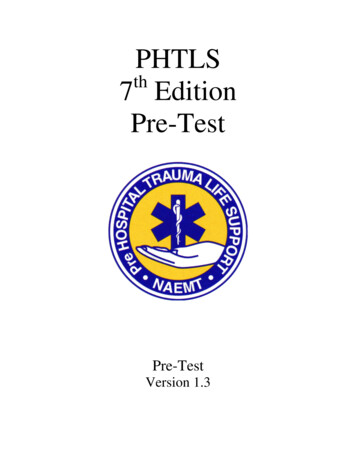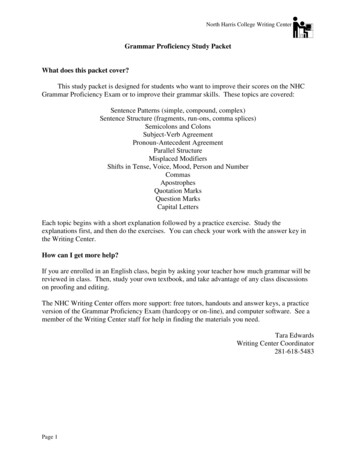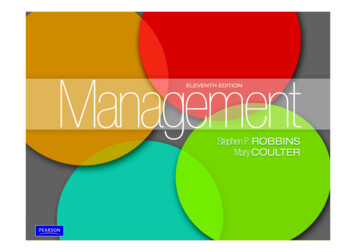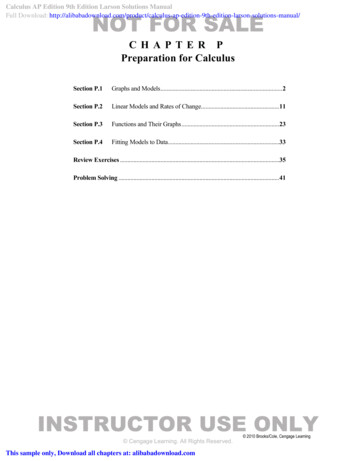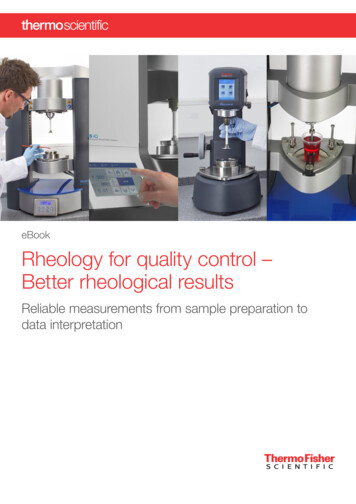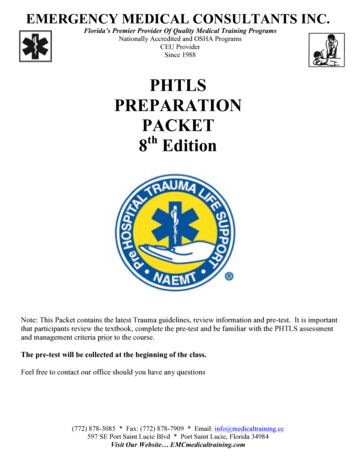
Transcription
EMERGENCY MEDICAL CONSULTANTS INC.Florida’s Premier Provider Of Quality Medical Training ProgramsNationally Accredited and OSHA ProgramsCEU ProviderSince 1988PHTLSPREPARATIONPACKET8th EditionNote: This Packet contains the latest Trauma guidelines, review information and pre-test. It is importantthat participants review the textbook, complete the pre-test and be familiar with the PHTLS assessmentand management criteria prior to the course.The pre-test will be collected at the beginning of the class.Feel free to contact our office should you have any questions(772) 878-3085 * Fax: (772) 878-7909 * Email: info@medicaltraining.cc597 SE Port Saint Lucie Blvd * Port Saint Lucie, Florida 34984Visit Our Website EMCmedicaltraining.com
Course Plan- 2 DayDay 115 minutes Welcome and Introduction60 minutes Baselines30 minutes Lesson 1: Introduction15 minutes Break45 minutes Lesson 2: Physiology of Life and Death30 minutes Lesson 3: Scene Assessment and Primary Assessment45 minutes Lesson 4: Airway60 minutes Lunch45 minutes Lesson 5: Breathing, Ventilation, and Oxygenation60 minutes Lesson 6: Circulation, Hemorrhage, and Shock15 minutes Break45 minutes Patient Simulations 1A - AB45 minutes Patient Simulations 1B - AB60 minutes Lesson 7: Disability - Part 1AdjournDay 230 minutes Group Discussion and Review Day One45 minutes Lesson 7: Disability - Part 230 minutes Lesson 8: Secondary Assessment15 minutes Break45 minutes Patient Simulations 2A - CD45 minutes Patient Simulations 2B - CD60 minutes Lunch30 minutes Lesson 9: Special Considerations45 minutes Patient Simulations 3A - M&P45 minutes Patient Simulations 3B - M&P15 minutes Break30 minutes Lesson 10: Summation90 minutes Final Written Evaluation and Final Evaluation Stations15 minutes Questions and AdjournThe optional lecture and optional skill stations, if offered, are to be given over and above the requiredprogram as outlined above.
PHTLS Assessment SequenceAssessmentAssess Scene Safety SituationResources needed?YESNONotify appropriate agenciesProceed when safeStandard PrecautionsAssess PatientAirwaySecure airway asneededNOPatent?Notes for Assessment AlgorithmYES1.Consider pleural decompression only if ALL arepresent: Diminished or absent breath sounds Increased work of breathing or difficultyventilating with bag-valve-mask Decompensated shock/hypotension (SBP 90mm Hg)**Perform bilateral pleural decompressiononly if patient is receiving positivepressure ventilation2.External hemorrhage control: Direct pressure/pressure dressing Tourniquet*Consider topical hemostatic agent for prolongedtransport3.Shock: tachycardia; cool, diaphoretic, pallorousskin; anxiety; diminished or absent peripheralpulses4.Quick check for other life-threatening conditions;cover patient to preserve body heat5.PASG should be considered for suspectedunstable pelvic fracture with hypotension6.Transport should not be delayed to initiate IVfluid therapy. Initiate two large-bore IV lines:uncontrolled bleed SBP 80-90, controlled bleed 12 liters titrate SBP 80-907.Splint fractures and dress wounds as neededBreathing?VR 10VR 12-20VR 20Auscultate breath sounds1Assist ventilationAuscultate breath soundsO2 to maintainSpO2 95%External hemorrhage?NOConsider assistingVentilation ( Vt)YESControl asappropriate2CirculationAssess for shock3Expose/ environment4Life threats present?YESNOSpinal immobilizationas indicatedAssess vital signsAMPLE historySecondary surveyConsider PASG5Reassess primary surveyTransportReassess primary surveyIV fluid therapy6Trauma centerIf availableYESLife threats?NODefinitive field care7Spinal immobilization as indicatedTransport to appropriate facility
PHTLS ShockTypes of Shock There are three types of shock: Hypovolemic shock Vascular volume smaller than normal vascular size Loss of blood and fluid Hemorrhagic shock Loss of fluid and electrolytes Dehydration Distributive shock Vascular space is larger than normal Neurogenic “shock” (hypotension) Psychogenic shock Septic shock Anaphylactic shock Cardiogenic shock Pump failureClassification of Hemorrhagic ShockClass IClass IIClass Mildly Decreased30-405-15Anxious, confusedCrystalloid and bloodClass IVBlood loss (mL)Blood loss (% vol)Pulse rateBlood pressurePulse pressureRespiratory rateUrine output (mL/hr)CNS/ mental statusFluid replacementUp to 750Up to 15% 100NormalNormal or increased14-20 30Slightly anxiousCrystalloid 2000 40% 140DecreasedDecreased 35NegligibleConfused, lethargicCrystalloid and bloodVital SignSkin temperatureSkin colorBlood pressureLevel ofconsciousnessCapillary refillingtimeHypovolemicCool, clammyPale, cyanoticDropsAlteredNeurogenicWarm, dryPinkDropsLucidSepticCool, clammyPale, mottledDropsAlteredCardiogenicCool, clammyPale, cyanoticDropsAlteredSlowedNormalSlowedSlowedSigns Associated with Types of ShockShock AssessmentVital SignPulseCompensatedIncreased; tachycardiaDecompensatedGreatly increased;marked tachycardiathat can progress tobradycardiaSkinWhite, cool, moistWhite, cold waxyBlood pressure rangeNormalDecreasedLevel of consciousnessUnalteredAltered, ranging fromdisoriented to comaType of FractureRibRadius or ulnaBlood Loss Potential125 mL250-500 mLHumerus500-750 mLTibia or fibula500-1000 mLFemur1000-2000 mLPelvis1000-unlimited mLManagement-Ensure oxygenation and ventilation-Control hemorrhage (external or internal)-External- direct pressure or tourniquet or homeostatic agent-Internal-direct pressure (extremity immobilization/ PASG for pelvis/ low abd.)* Consider Tranexamic Acid (TXA) for uncontrollablebleeds.-Move toward a definitive facility-Control body temp (lower the pt)-Fluid replacement for Class II, III, or IV shock-Ideally blood or packed RBC’s (though not available prehospital)-Isotonic crystalloids (Preferable no LR), replace at 3mL’s per mL’s blood loss (ideally warm)-Controllable bleeds- 1-2 liters (adult) (20 mL/kg peds) – Titrated to SBP 80-90 mmHg-Uncontrolled (internal) bleeds- the least amount of fluid required to maintain SBP 80-90 mmHg
Spine Board Debate- Pg. 305It is agreed that the long board is an appropriate device for extrication and patient movement on scene and to astretcher, but 2015 brought about documented controversy as to its effectiveness at truly immobilizing the spineand its benefits; Key Issues:- There are no documented studies to support that straight rigid board immobilization with a collar isbeneficial.- Some patients’ anatomy actually flexes the head forward while others hyperextend the head when placed ona board.- Patients will all begin to complain of neck and back pain if left on a hard board.- Skin breakdown can occur at points that contact the board.- Obese patients are at risk for positional asphyxia- Emergency airway procedures are more difficult to perform on immobilized patientsThe lack of supporting benefit and the growing potential for detrimental side effects has led many areas to decreaseor completely remove the use of spine boards for anything more than extrication or movement. Instead opting forplacing a collar on the patient and lying the spine on the stretcher.At the publishing of the 8th Edition text (2016) this remains a controversial change and may be different by region.
PHTLS 8th Ed. FINAL EVALUATION STATION FLOW SHEETStudent (Leader):Evaluator: Scenario Number:Beginning Time: Ending Time:CompletedYesNoAssessment & TreatmentIdentify Safe SceneProper Standard PrecautionsPerform Primary SurveyLevel of ir ExchangeCirculation/PerfusionExternal Hemorrhage ControlPulseSkin ConditionDisabilityExposure of All Critical Body Areas for AssessmentProperly Identify Critical and Non-Critical Trauma PatientsUse of Appropriate Spinal Immobilization Technique(s)Proper Use of Padding/Buttress MaterialIdentification of All Life-Threatening InjuriesProper Treatment of All Life-Threatening InjuriesPerformed Only Lifesaving Treatment(s) While On-SceneTimely Transported When IndicatedAppropriate Level Trauma Facility When IndicatedIdentification of All Non-Critical InjuriesAny mark(s) within the critical criteria area would indicatethe need for the group to repeat the station. Only mark thosecomments that apply to the scenario. Please documentrationale for any checked critical criteria in the notation area.Critical CriteriaFailure to utilize proper standard precaution techniquesFailure to identify safe sceneFailure to perform adequate/complete primary safetyFailure to identify all life-threateninginjuries/conditionsFailure to immediately treat life-threatening injuries/conditionsFailure to identify critical patient based on assessmentPerformed unnecessary treatment on-scenePerformed secondary survey before primary surveyFailure to assess and treat noncritical injuriesFailure to provide timely transport to an appropriatelevel trauma facilityFailure to reassess the patient’s conditionFailure to perform scenario in a safe mannerFailure to perform in a team fashionFailure to complete scenario within 10 minutes of onscene timeNOTES:Proper Treatment Performed En-RouteCompleted Secondary Survey When IndicatedCompleted Scenario Within 10 Minutes On-Scene TimeReassessment of Patient's ConditionsSafety Observed Throughout ScenariosWorked Together as A TeamSuccessful Station Completion: YES NO
PHTLS 8th EDITION PRETESTPlease respond to each question with the most correct answer from the given choices. There is only one answerfor each question.1. You arrive at the scene of a motor vehicle collision in which a vehicle struck a tree. Which is the best indicator ofpotential injury?A) Circumference of the vehicleB) Diameter of the treeC) Mass of the vehicleD) Speed of the vehicle2. The potential for death or serious injury is greatest in which of the following motor vehicle collisions?A) Down and underB) Ejection from vehicleC) Lateral compressionD) Up and over3. Bilateral femur fractures are most often associated with which type of motorcycle crash?A) Angular impactB) Bike-road impactC) Head-on impactD) Rear impact4. Which is the preferred fluid for resuscitation of hemorrhagic shock in the prehospital setting?A) 5% dextrose in waterB) 7.5% hypertonic salineC) HetastarchD) Lactated Ringer’s5. Which is the most common cause of upper airway obstruction in the trauma patient?A) BloodB) TeethC) TongueD) Vomitus6. Which is the preferred adjunct device for verifying placement of an endotracheal tube in a patient with a perfusingrhythm?A) End-tidal CO2 monitoring (capnography)B) Esophageal detector deviceC) Pulse oximeterD) Stethoscope7. Which is the most important reason to maintain an open airway in the trauma patient?A) Prevents aspiration and pneumoniaB) Prevents hypoxemia and hypercarbiaC) Prevents snoring respirationsD) Prevents the tongue from blocking the pharynx
8. Essential airway skills include manual clearing of the airway, manual maneuvers, suctioning and which of thefollowing?A) Dual lumen airwayB) Endotracheal intubationC) Laryngeal mask airwayD) Oropharyngeal airway9. Your patient is a middle aged male who crashed his motorcycle. He is unresponsive. After opening the airway usinga modified jaw thrust, you note the patient has respirations at a rate of 6. Auscultation reveals breath sounds are absenton the left side. Which of the following is the most appropriate next intervention?A) Apply a non-rebreather maskB) Begin ventilation with a BVMC) Insert an endotracheal tubeD) Perform a needle decompression10. Which best describes shock?A) Decreased Glasgow Coma Scale (GCS)B) Flushed, dry, hot skin combined with bradycardiaC) Generalized inadequate tissue perfusionD) Low blood pressure combined with tachycardia11. Your patient has a deep laceration to his antecubital fossa with significant bleeding. What is the most appropriateinitial action?A) Apply a tourniquetB) Apply direct pressureC) Initiate rapid transportD) Restore blood volume12. Hypotension of unknown etiology in a trauma patient should be assumed to result from which of the following?A) Blood lossB) Cardiac tamponadeC) Spinal injuryD) Tension pneumothorax13. Which assessment is most beneficial in differentiating hemorrhagic shock from neurogenic shock in the prehospitalsetting?A) AbdomenB) Blood pressureC) Neurologic statusD) Skin14. The body initially compensates for blood loss through activation of which of the following?A) Parasympathetic nervous systemB) Reticular activating systemC) Spinal reflex arcsD) Sympathetic nervous system15. Medication used by trauma patients for pre-existing conditions may cause which of the following?A) Herbal preparations may enhance blood clottingB) Anti-inflammatory agents may enhance blood clottingC) Beta blockers may prevent tachycardia with blood lossD) Calcium channel blockers may slow the onset of shock
16. The target blood pressure for a trauma patient with suspected intraabdominal hemorrhage is which of thefollowing?A) 60 – 70mm HgB) 80 – 90 mm HgC) 100 – 110 mm HgD) 120 – 130 mm Hg17. Which best explains the mechanism by which gas exchange is impaired in pulmonary contusion?A) Blood in the alveoliB) Collapse of the alveoliC) Compression of the lung tissueD) Partial occlusion of the bronchi18. Which of the following is a key finding that differentiates cardiac tamponade from tension pneumothorax?A) Distended jugular veinsB) Equal breath soundsC) HypotensionD) Tachycardia19. Your patient is a 20 year old male who struck his head on a teammate’s knee while diving to catch a football. Hewas not wearing a helmet. He demonstrates decerebrate posturing and has a GCS score of 4. His heart rate is 58, bloodpressure 180/102 and his left pupil is dilated. What is the best ventilation rate to use when managing this patient?A) 10 breaths per minute.B) 20 breaths per minute.C) 30 breaths per minute.D) 35 breaths per minute.20. A 20 year old female
PHTLS 8th EDITION PRETEST Please respond to each question with the most correct answer from the given choices. There is only one answer for each question. 1. You arrive at the scene of a motor vehicle collision in which a vehicle struck a tree. Which is the best indicator of potential injury? A) Circumference of the vehicle B) Diameter of the tree
